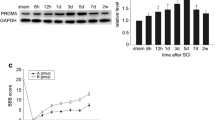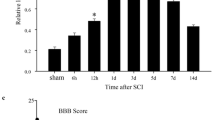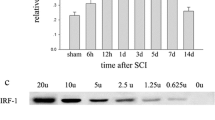Abstract
Foxj2 (forkhead box J2), a novel member of the forkhead/HNF3 family, binds DNA with a dual sequence specificity. It may play a role in maintenance and survival of developing and adult neurons. However, its expression and function in the central nervous system lesion are still unclear. In this study, we performed a spinal cord injury (SCI) model in adult Sprague–Dawley rats and investigated the dynamic changes of Foxj2 expression in the spinal cord. Western blot analysis revealed that Foxj2 was present in normal spinal cord. It gradually increased, reached a peak at day 5 after SCI, and then declined during the following days. Double immunofluorescence staining revealed wide expression of Foxj2, which is detected in neurons and astrocytes. After injury, Foxj2 expression was increased predominantly in astrocytes, which highly expressed proliferating cell nuclear antigen, a marker for proliferating cells. And knockdown of Foxj2 in cultured primary astrocytes by siRNA showed that Foxj2 played an important role in lipopolysaccharide-induced inflammatory responses. These results suggested that Foxj2 may be involved in the pathophysiology of SCI, and further research is needed to have a good understanding of its function and mechanism.




Similar content being viewed by others
References
Amat JA, Ishiguro H, Nakamura K, Norton WT (1996) Phenotypic diversity and kinetics of proliferating microglia and astrocytes following cortical stab wounds. Glia 16:368–382
Beattie MS (2004) Inflammation and apoptosis: linked therapeutic targets in spinal cord injury. Trends Mol Med 10:580–583
Benveniste EN (1997) Cytokines: influence on glial cell gene expression and function. Chem Immunol 69:31–75
Benveniste EN (1998) Cytokine actions in the central nervous system. Cytokine Growth Factor Rev 9:259–275
Carlsson P, Mahlapuu M (2002) Forkhead transcription factors: key players in development and metabolism. Dev Biol 250:1–23
Codeluppi S, Svensson CI, Hefferan MP et al (2009) The Rheb-mTOR pathway is upregulated in reactive astrocytes of the injured spinal cord. J Neurosci 29:1093–1104
Fan W, Morinaga H, Kim JJ et al (2010) FoxO1 regulates Tlr4 inflammatory pathway signalling in macrophages. EMBO J 29:4223–4236
Filosa S, Rivera-Perez JA, Gomez AP et al (1997) Goosecoid and HNF-3beta genetically interact to regulate neural tube patterning during mouse embryogenesis. Development 124:2843–2854
Ghashghaei HT, Weimer JM, Schmid RS et al (2007) Reinduction of ErbB2 in astrocytes promotes radial glial progenitor identity in adult cerebral cortex. Genes Dev 21:3258–3271
Glass CK, Saijo K, Winner B, Marchetto MC, Gage FH (2010) Mechanisms underlying inflammation in neurodegeneration. Cell 140:918–934
Granadino B, Arias-de-la-Fuente C, Perez-Sanchez C et al (2000) Fhx (Foxj2) expression is activated during spermatogenesis and very early in embryonic development. Mech Dev 97:157–160
Gruner JA (1992) A monitored contusion model of spinal cord injury in the rat. J Neurotrauma 9:123–128
Hannenhalli S, Kaestner KH (2009) The evolution of Fox genes and their role in development and disease. Nat Rev Genet 10:233–240
Hausmann ON (2003) Post-traumatic inflammation following spinal cord injury. Spinal Cord 41:369–378
Herrera E, Marcus R, Li S et al (2004) Foxd1 is required for proper formation of the optic chiasm. Development 131:5727–5739
Hong HK, Noveroske JK, Headon DJ et al (2001) The winged helix/forkhead transcription factor Foxq1 regulates differentiation of hair in satin mice. Genesis 29:163–171
Kalin TV, Meliton L, Meliton AY, Zhu X, Whitsett JA, Kalinichenko VV (2008) Pulmonary mastocytosis and enhanced lung inflammation in mice heterozygous null for the Foxf1 gene. Am J Respir Cell Mol Biol 39:390–399
Kaufmann E, Knochel W (1996) Five years on the wings of fork head. Mech Dev 57:3–20
Labosky PA, Winnier GE, Jetton TL et al (1997) The winged helix gene, Mf3, is required for normal development of the diencephalon and midbrain, postnatal growth and the milk-ejection reflex. Development 124:1263–1274
Lal G, Yin N, Xu J et al (2011) Distinct inflammatory signals have physiologically divergent effects on epigenetic regulation of Foxp3 expression and Treg function. Am J Transplant 11:203–214
Lee KS, Yang WI (1992) Comparison of brain tumor growth kinetics by proliferating cell nuclear antigen (PCNA) and bromodeoxyuridine (BrdU) labeling. Yonsei Med J 33:265–271
Lin L, Peng SL (2006) Coordination of NF-kappaB and NFAT antagonism by the forkhead transcription factor Foxd1. J Immunol 176:4793–4803
Lin K, Dorman JB, Rodan A, Kenyon C (1997) daf-16: An HNF-3/forkhead family member that can function to double the life-span of Caenorhabditis elegans. Science 278:1319–1322
Lin L, Spoor MS, Gerth AJ, Brody SL, Peng SL (2004) Modulation of Th1 activation and inflammation by the NF-kappaB repressor Foxj1. Science 303:1017–1020
Liu L, Rudin M, Kozlova EN (2000) Glial cell proliferation in the spinal cord after dorsal rhizotomy or sciatic nerve transection in the adult rat. Exp Brain Res 131:64–73
Lu J, Ashwell KW, Waite P (2000) Advances in secondary spinal cord injury: role of apoptosis. Spine 25:1859–1866
Madson JG, Lynch DT, Tinkum KL, Putta SK, Hansen LA (2006) Erbb2 regulates inflammation and proliferation in the skin after ultraviolet irradiation. Am J Pathol 169:1402–1414
McDonald JW, Sadowsky C (2002) Spinal-cord injury. Lancet 359:417–425
Morris GF, Mathews MB (1989) Regulation of proliferating cell nuclear antigen during the cell cycle. J Biol Chem 264:13856–13864
Nicole O, Goldshmidt A, Hamill CE et al (2005) Activation of protease-activated receptor-1 triggers astrogliosis after brain injury. J Neurosci 25(17):4319–4329
Park E, Velumian AA, Fehlings MG (2004) The role of excitotoxicity in secondary mechanisms of spinal cord injury: a review with an emphasis on the implications for white matter degeneration. J Neurotrauma 21:754–774
Perez-Sanchez C, Gomez-Ferreria MA, de La Fuente CA et al (2000) FHX, a novel fork head factor with a dual DNA binding specificity. J Biol Chem 275:12909–12916
Perry VH, Nicoll JA, Holmes C (2010) Microglia in neurodegenerative disease. Nat Rev Neurol 6:193–201
Ridet JL, Malhotra SK, Privat A, Gage FH (1997) Reactive astrocytes: cellular and molecular cues to biological function. Trends Neurosci 20:570–577
Rivieccio MA, John GR, Song X et al (2005) The cytokine IL-1β activates IFN response factor 3 in human fetal astrocytes in culture. J Immunol 174:3719–3726
Saijo K, Winner B, Carson CT et al (2009) A Nurr1/CoREST pathway in microglia and astrocytes protects dopaminergic neurons from inflammation-induced death. Cell 137:47–59
Sekhon LH, Fehlings MG (2001) Epidemiology, demographics, and pathophysiology of acute spinal cord injury. Spine (Phila Pa 1976) 26:S2–S12
Shi C, Sakuma M, Mooroka T et al (2008) Down-regulation of the forkhead transcription factor Foxp1 is required for monocyte differentiation and macrophage function. Blood 112:4699–4711
Sofroniew MV, Vinters HV (2010) Astrocytes: biology and pathology. Acta Neuropathol 119:7–35
Tawfik VL, Lacroix-Fralish ML, Bercury KK, Nutile-McMenemy N, Harris BT, Deleo JA (2006) Induction of astrocyte differentiation by propentofylline increases glutamate transporter expression in vitro: heterogeneity of the quiescent phenotype. Glia 54:193–203
Vargha-Khadem F, Gadian DG, Copp A, Mishkin M (2005) FOXP2 and the neuroanatomy of speech and language. Nat Rev Neurosci 6:131–138
Wijchers PJ, Hoekman MF, Burbach JP, Smidt MP (2006) Identification of forkhead transcription factors in cortical and dopaminergic areas of the adult murine brain. Brain Res 1068:23–33
Wyndaele M, Wyndaele JJ (2006) Incidence, prevalence and epidemiology of spinal cord injury: what learns a worldwide literature survey? Spinal Cord 44:523–529
Yadav A, Collman RG (2009) CNS inflammation and macrophage/microglial biology associated with HIV-1 infection. J Neuroimmune Pharmacol 4:430–447
Acknowledgments
This work was supported by Key Medical Personnel Foundation of Jiangsu Province (RC2007027) and Health Project of Jiangsu Province (H200632).
Author information
Authors and Affiliations
Corresponding author
Additional information
Xiang Chen and Xingjian Cao contributed equally to this work.
Rights and permissions
About this article
Cite this article
Chen, X., Cao, X., Tao, G. et al. Foxj2 Expression in Rat Spinal Cord After Injury and Its Role in Inflammation. J Mol Neurosci 47, 158–165 (2012). https://doi.org/10.1007/s12031-011-9704-2
Received:
Accepted:
Published:
Issue Date:
DOI: https://doi.org/10.1007/s12031-011-9704-2




